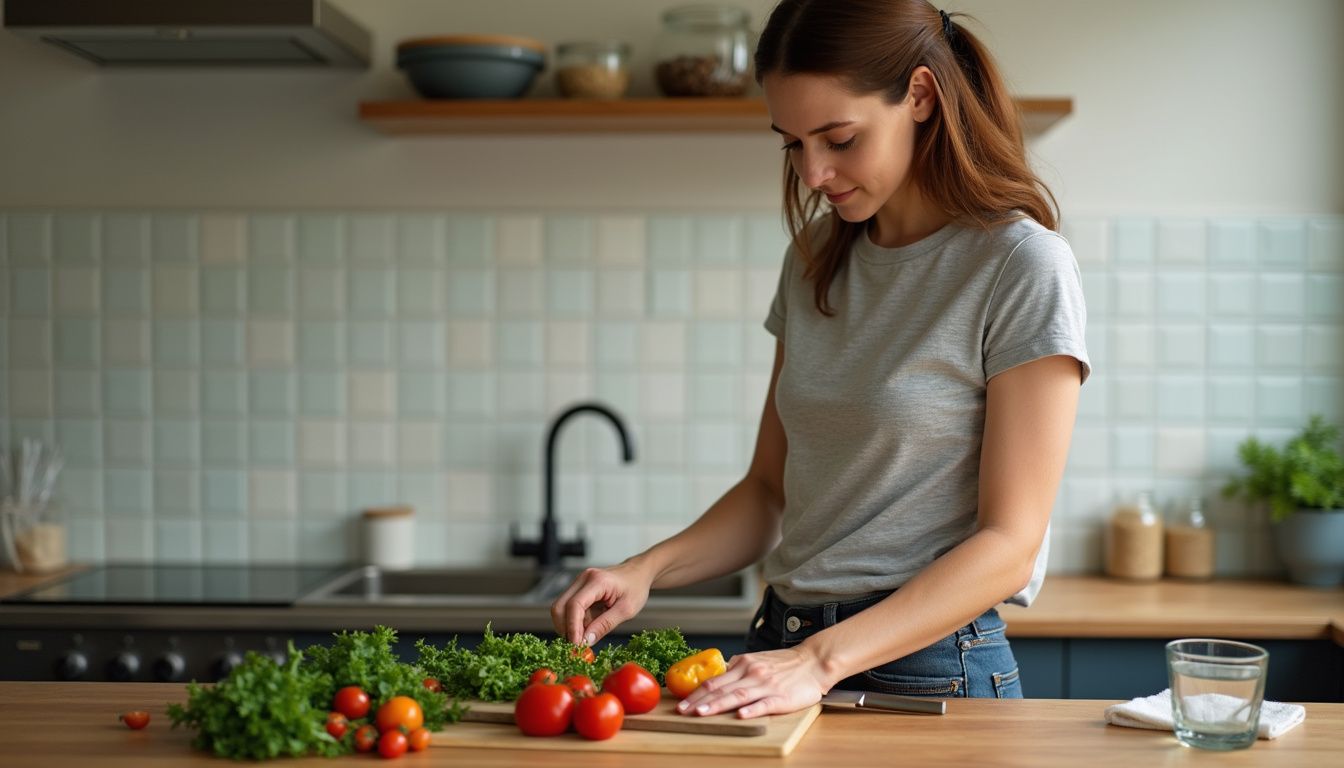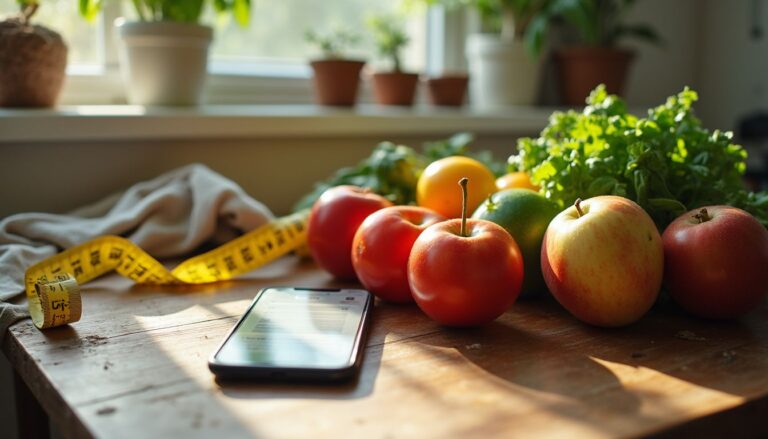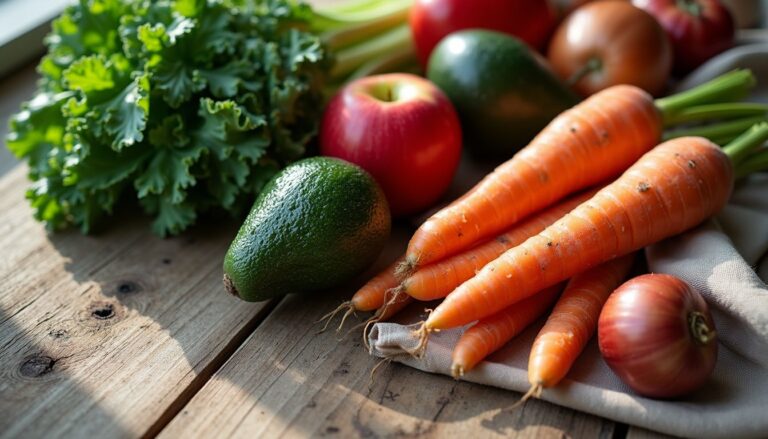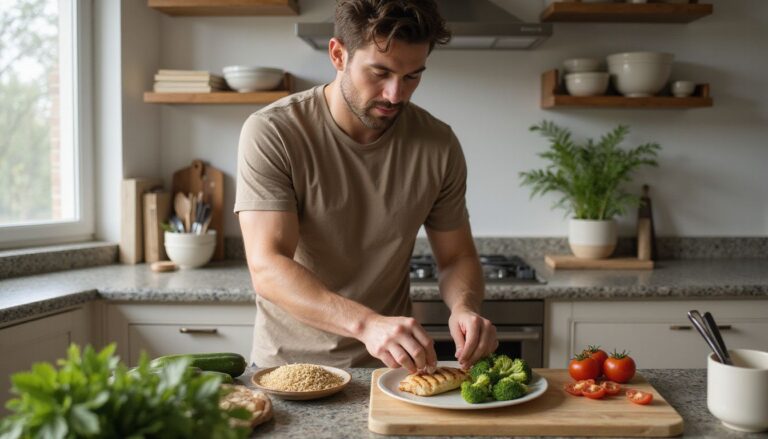7-Day Beginner Diet Plan For Weight Loss For Female: A Step-by-Step Meal Guide
Our Nutrition Assistant AI Suite will transform your body. You will lose fat, get toned, and build muscle. Gain confidence and optimal health.
Ready to start a simple meal plan that helps you lose weight without guessing? A structured 7-day beginner diet plan gives you clear steps, balanced meals, and steady progress you can feel. This guide shows exactly what to eat each day, using budget-friendly foods and easy prep.
You will learn how to build a weight loss plan that fits real life. The plan uses whole foods, smart portions, and hydration to support healthy habits. Start small, stay consistent, and watch your confidence grow.
Key Takeaways
- A 7-day beginner plan for women often uses about 1,200 calories per day, which can support a loss of 1 to 2 pounds per week under general health guidance.
- Dietary Guidelines suggest 45 to 65% of calories from carbs, 10 to 35% from protein, and 20 to 35% from fat.
- Build meals with lean protein, whole grains, fruits and vegetables, and healthy fats like nuts or olive oil.
- In a 2019 Cell Metabolism study, people ate roughly 500 more calories per day on ultra-processed foods compared with whole foods.
- Replacing sugary drinks with water lowers total calories and supports better weight management.
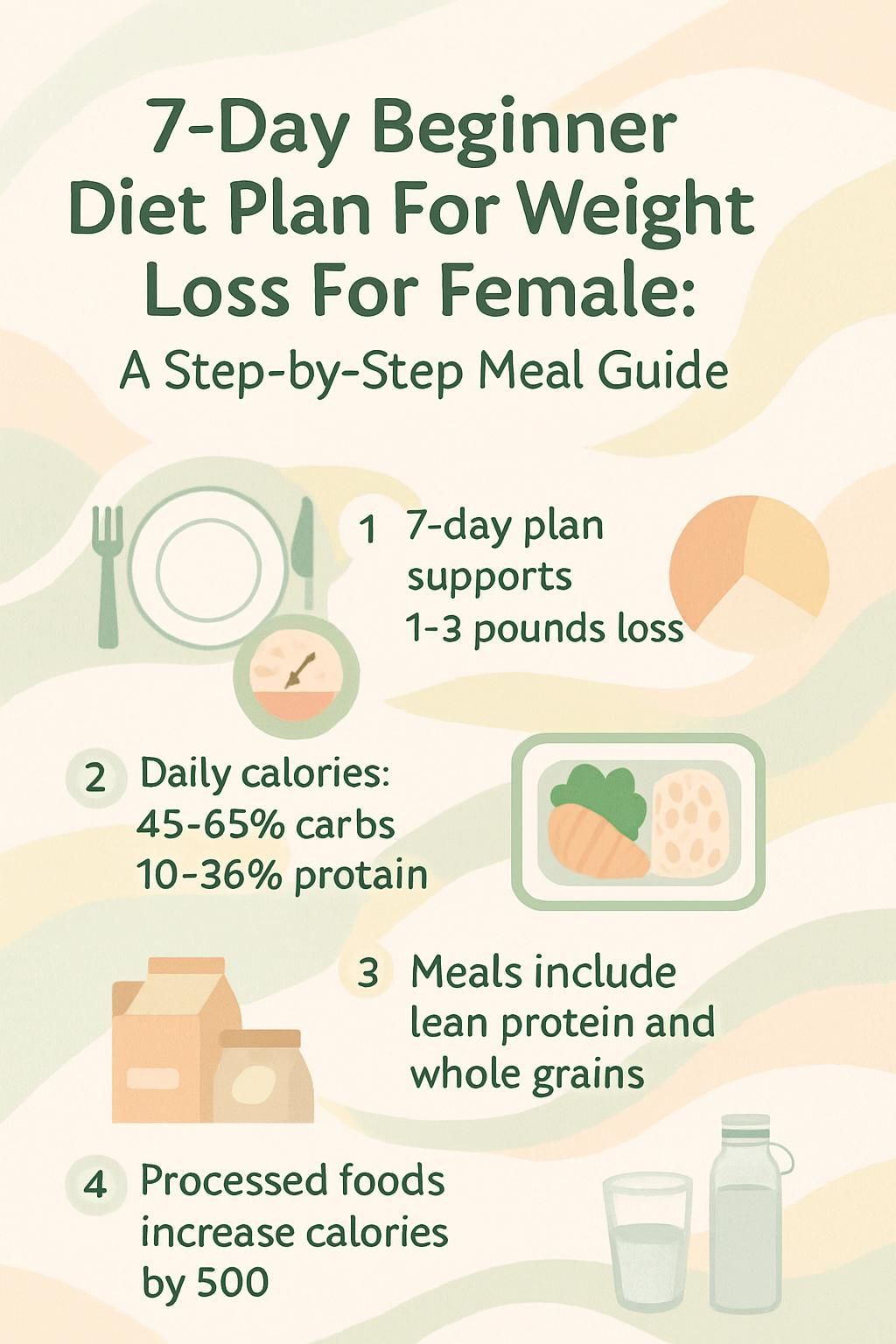
Why is a beginner diet plan important for weight loss?

A beginner plan gives you structure. It teaches portion sizes, sets a daily rhythm, and removes guesswork. For many women ages 19 to 50 who want to lose weight, a 1,200-calorie plan can be a starting point, though needs vary by size, health, and activity.
Whole, minimally processed foods help you aim for 1 to 2 pounds lost per week, which aligns with safe rates from major health organizations. You also build skills that last, like planning, prepping, and reading hunger cues.
Creating new habits starts with simple steps and clear daily goals.
Confidence grows as you see progress, which helps you stick with your weight loss meal plan. This approach supports fat loss and may lower risks related to high blood pressure and type 2 diabetes. If you have a medical condition, are pregnant, or have special nutrition needs, talk with your healthcare provider or a registered dietitian first.
Key principles of an effective 7-day diet plan
A simple structure makes daily choices easier. Use these principles to guide each plate and snack.
What are balanced macronutrients and why do they matter?
Macronutrients are carbs, protein, and fat. The 2020 to 2025 Dietary Guidelines suggest 45 to 65% of calories from carbs, 10 to 35% from protein, and 20 to 35% from fat. Hitting these ranges helps energy, fullness, and muscle support.
Pick complex carbs such as oats, brown rice, and quinoa for steady energy. Choose lean protein like chicken breast, eggs, tofu, and legumes to support muscles while losing excess weight. Add healthy fats from nuts, seeds, avocado, and olive oil to absorb vitamins and feel satisfied.
Example: whole grain toast with scrambled eggs and a side of berries gives a balanced start to the day.
How can portion control help with weight loss?
Portion control lowers calories without cutting entire food groups. Use smaller plates, measure snacks, and pre-portion items like nuts or yogurt. This keeps high-calorie foods in check and makes your daily diet meal plan easier to follow.
Home cooking gives control over ingredients and serving sizes compared to dining out. Prepping meals ahead reduces last-minute choices and helps you stay on track during busy days.
Why is hydration important during a diet plan?
Water supports digestion, curbs hunger, and stabilizes energy. Swapping soda or sweet tea for water cuts significant calories. Many people report fewer cravings and better focus when well hydrated.
Fruits and vegetables with high water content, like cucumbers and berries, can help you meet fluid needs. Hydration also supports steady blood sugar and regular digestion.
How does consistency affect weight loss success?
Eating on a regular schedule helps your body know what to expect. Plan three meals and one or two snacks each day. Consistent routines limit grazing and late-night overeating.
Meal tracking or planning improves awareness and helps you notice patterns. Picking fiber-rich foods, like beans and leafy greens, supports fullness and consistency throughout the week.
Which foods should you include in your diet plan?
Build most meals from these food groups. They make it easier to meet your goals and feel satisfied.
What are the best lean protein options for weight loss?
Top picks include chicken breast, turkey, tofu, eggs, and legumes. These choices offer high protein with fewer calories from fat.
- Chicken breast: about 26 grams protein per 3 ounces, under 3 grams fat.
- Tofu: about 10 grams protein per half cup, a strong plant option.
- Eggs: about 6 grams protein each, very filling for the calories.
- Lentils, black beans, chickpeas: about 7 to 9 grams protein per half cup cooked.
If hunger lingers, add about 1 to 2 ounces more protein at a meal. This can improve satiety without many extra calories.
Why choose whole grains for your meals?
Whole grains keep you full longer and support digestion. Brown rice, oats, whole wheat bread, and quinoa contain fiber, B vitamins, and minerals that refined grains lose during processing.
Try oatmeal at breakfast, quinoa in salads, or brown rice as a dinner base. These options are budget friendly and easy to cook in batches.
How do fresh fruits and vegetables support weight loss?
Fruits and vegetables are low in calories and high in fiber, which adds volume to meals. You feel full on fewer calories.
Snack on apples, berries, carrots, or cucumbers. Aim for at least five servings per day to support heart health, lower diabetes risk, and boost energy. Pair produce with cottage cheese or grilled chicken for longer-lasting fullness.
What healthy fats should you add to your diet?
Healthy fats improve flavor, satisfaction, and nutrient absorption. Good sources include olive oil, almonds, walnuts, sunflower seeds, avocado, and salmon.
Try a smoothie with almond butter, toast with peanut butter, or a salad dressed with olive oil and vinegar. The USDA recommends 20 to 35% of calories from fats, focusing on unsaturated sources.
What foods should you avoid during weight loss?
Some foods make it harder to reach your goals. Limiting them can speed your progress and improve health markers.
Why avoid processed foods when trying to lose weight?
Chips, cookies, and sugary cereals often pack added sugar, sodium, and unhealthy fats. These calories come fast and do not provide many nutrients.
In a 2019 Cell Metabolism study, people consumed about 500 extra calories per day on ultra-processed diets compared with whole foods. Whole options, like eggs or roasted sweet potato, support steady energy and better appetite control.
How do sugary drinks impact weight loss efforts?
Sodas, sweet teas, and energy drinks add calories with little nutrition. One can of soda adds about 150 calories, which can stall progress.
Switch to water, seltzer, or unsweetened tea. Many studies show that replacing sugary beverages supports weight loss and improves long-term weight management.
What are refined carbohydrates and why limit them?
Refined carbs, such as white bread and white pasta, are stripped of fiber and nutrients. They digest quickly, which can spike blood sugar and trigger hunger soon after.
Swap in whole grains like brown rice or whole wheat tortillas. For example, one cup of cooked brown rice has about 3 grams of fiber while the same amount of white rice has about 0.5 grams.
Why should trans fats be avoided in a diet plan?
Trans fats raise LDL cholesterol and lower HDL cholesterol. They show up in many packaged snacks and some fast foods.
Choose oils like olive oil and opt for low-fat or fat-free dairy to reduce intake. Replacing packaged desserts with fruit and nuts can boost energy and make meals feel lighter.
Sample 7-day meal plan for beginners
Here is a flexible plan that highlights balance, flavor, and simple prep. Adjust portions to match your calorie needs and activity level.
Day 1:
Breakfast brings Greek yogurt with berries and a light sprinkle of granola. This mix gives protein, fiber, and natural sweetness to start the day strong.
For lunch, build a grilled chicken salad with lettuce, tomatoes, onions, and bell peppers. Add an olive oil dressing for healthy fats and toss in a few chopped nuts for crunch.
Dinner features baked salmon, quinoa, and steamed broccoli. Salmon supplies omega-3 fats, quinoa adds complete protein, and broccoli brings fiber with very few calories.
Prep tip: wash and chop vegetables for two days at once to save time.
Breakfast: Greek yogurt with berries and granola
Greek yogurt offers about 10 grams of protein per 100 grams and pairs well with berries rich in vitamin C. Choose a low-sugar granola to manage calories.
Add banana slices or cinnamon for more flavor. This breakfast keeps hunger steady and works well on busy mornings.
Lunch: Grilled chicken salad with olive oil dressing
Lean chicken gives high-quality protein to protect muscle during weight loss. Fresh vegetables add fiber and volume for few calories.
Use a simple oil and vinegar dressing. Serve with a small side of whole grains or a scoop of hummus if you need extra energy.
Dinner: Baked salmon with quinoa and steamed broccoli
Salmon supports heart health and muscle repair. Quinoa brings protein and fiber. Steamed broccoli provides vitamins with minimal calories.
Season with garlic, lemon, or a small amount of mustard. Steaming the broccoli preserves more nutrients than boiling.
Day 2:
Begin day 2 with oatmeal topped with almond butter and banana. Oats provide complex carbs for steady energy, and nut butter adds healthy fats.
Lunch is a turkey and avocado wrap on a whole wheat tortilla. Dinner is stir-fried tofu with brown rice and mixed vegetables such as bell peppers and broccoli.
This lineup balances carbs, protein, and fiber for solid appetite control.
Breakfast: Oatmeal with almond butter and banana slices
Oatmeal helps keep blood sugar stable. Two tablespoons of almond butter add protein and monounsaturated fats that support heart health.
Banana brings potassium and natural sweetness. Many people find this combo reduces midmorning cravings.
Lunch: Turkey and avocado wrap with whole wheat tortilla
Turkey offers lean protein. Avocado brings healthy fats and fiber. The whole wheat wrap adds complex carbs for sustained energy.
Add spinach or lettuce for more crunch and vitamins. This lunch typically lands around 300 to 350 calories.
Dinner: Stir-fried tofu with brown rice and mixed vegetables
Tofu supplies plant protein. Brown rice provides fiber and a slow, steady release of energy. Mixed vegetables increase volume and nutrients without many calories.
This quick dinner supports your goals and is easy to portion for leftovers.
Day 3:
Start with scrambled eggs and spinach plus whole grain toast. Lunch is lentil soup and a side salad. Dinner brings grilled shrimp with sweet potato and asparagus.
These pairings deliver protein, fiber, and vitamins to manage hunger and support consistent energy throughout the day.
…
Breakfast: Scrambled eggs with spinach and whole grain toast
Two eggs provide about 12 grams of protein plus choline for brain function. Spinach adds iron and magnesium, and whole grain toast supplies complex carbs.
This breakfast comes together in under 10 minutes and keeps you fueled until lunch.
Lunch: Lentil soup with a side of mixed greens
One cup of lentil soup often contains around 18 grams of protein and 15 grams of fiber for roughly 230 calories. That combination helps control appetite for hours.
Pair with mixed greens and a light vinaigrette for more vitamins and crunch.
Dinner: Grilled shrimp with sweet potato and asparagus
Three ounces of shrimp provide about 18 grams of protein for only about 84 calories. Sweet potato gives fiber and slow-digesting carbs, and asparagus adds folate and vitamin K.
This meal is light, fast, and satisfying.
Day 4:
Enjoy a smoothie with spinach, mango, and almond milk for breakfast. Lunch is quinoa salad with chickpeas and cucumbers. Dinner features herb-roasted chicken, wild rice, and green beans.
Planning your meals for the day in the morning can save time and reduce stress at night.
Breakfast: Smoothie with spinach, mango, and almond milk
Spinach delivers vitamin A. Mango adds vitamin C and natural sweetness. Almond milk is a low-calorie base with a mild flavor.
This blend offers fiber and hydration that support digestion and help curb cravings.
Lunch: Quinoa salad with chickpeas and cucumbers
Quinoa and chickpeas combine for a protein and fiber boost. Cucumbers bring crunch and extra hydration.
Finish with lemon juice and black pepper. This salad packs well and tastes great cold.
Dinner: Herb-roasted chicken with wild rice and green beans
Lean chicken supports muscle health. Wild rice adds fiber and minerals. Green beans supply potassium and antioxidants.
Herbs add flavor without extra calories. This is a dependable weeknight dinner.
Day 5:
Breakfast is whole grain toast topped with avocado and boiled eggs. Lunch is a grilled vegetable wrap with hummus. Dinner brings baked cod with mashed cauliflower and roasted carrots.
These meals deliver protein, fiber, and healthy fats for steady energy and good appetite control.
Breakfast: Whole grain toast with avocado and boiled eggs
Whole grains release energy slowly. Avocado adds healthy fat and fiber. Eggs provide protein and B vitamins.
Top with sliced tomato or a small orange on the side for extra vitamin C.
Lunch: Grilled vegetable wrap with hummus
Load a whole wheat wrap with grilled zucchini, peppers, and spinach. Hummus adds plant protein and richness.
This lunch often ranges from 300 to 350 calories and keeps you full through the afternoon.
Dinner: Baked cod with mashed cauliflower and roasted carrots
A fillet of cod has about 90 calories and 20 grams of protein. Mashed cauliflower is light and creamy with far fewer calories than potatoes. Carrots add color and vitamin A.
Season with lemon or mustard for brightness without heavy sauces.
Day 6:
Start with cottage cheese, pineapple, and walnuts. Lunch is zucchini noodles with marinara and turkey meatballs. Dinner includes grilled steak with roasted Brussels sprouts and a side salad.
This day balances higher-protein meals with colorful vegetables to support recovery and fullness.
Breakfast: Cottage cheese with pineapple and walnuts
One cup of cottage cheese offers around 24 grams of protein. Pineapple adds vitamin C and manganese. Walnuts bring omega-3 fats for brain health.
Choose low-fat cottage cheese to lower calories if needed.
Lunch: Zucchini noodles with marinara and turkey meatballs
Zucchini noodles cut carbs and calories compared to pasta. Turkey meatballs add lean protein, and tomato sauce provides antioxidants like lycopene.
Keep meatballs about one ounce each to manage portions.
Dinner: Grilled steak with roasted Brussels sprouts and a side salad
A 3-ounce steak provides about 22 grams of protein plus iron and zinc. Brussels sprouts add fiber and vitamin C. A simple side salad rounds out the plate.
Season with mustard and black pepper for flavor without excess calories.
Day 7:
Begin with chia seed pudding topped with berries. Lunch is a chicken Caesar salad with a light dressing. Dinner is a vegetable curry with brown rice. If you want dessert, choose a small square of dark chocolate.
This final day reinforces the habits you built and keeps meals balanced and satisfying.
Breakfast: Chia seed pudding with fresh berries
Two tablespoons of chia seeds provide nearly 10 grams of fiber, which supports fullness and digestion. Berries add antioxidants and natural sweetness with few calories.
Soak chia in almond milk or low-fat milk the night before for a fast morning meal.
Lunch: Chicken Caesar salad with a light dressing
Grilled chicken supplies lean protein. Romaine lettuce brings crunch, folate, and vitamin K. A light dressing trims calories and saturated fat.
Add a small amount of Parmesan and whole grain croutons for taste and texture.
Dinner: Vegetable curry with brown rice
Brown rice offers complex carbs for steady energy. A colorful curry with carrots, peppers, and peas supplies fiber and micronutrients.
Cook extra for tomorrow’s lunch to save time and reduce food waste.
How can you prepare your meals efficiently?
Planning and prep make healthy eating easier. Set up your week so good choices are the default, not the exception.
Why plan your meals in advance?
Meal planning supports portions and lowers impulse eating. A short shopping list saves money and reduces stress during busy weeks.
People who plan meals often improve diet quality and stick to their goals more consistently.
How to use leftovers creatively?
Turn extra grilled chicken into next-day salad. Add roasted vegetables to a whole grain wrap. These simple swaps save time and reduce waste.
Cooked quinoa can become a breakfast bowl with fruit and yogurt. Leftover fish or tofu can enrich soups for more protein.
What are the benefits of cooking in batches?
Batch cooking saves hours and helps with portion control. You prepare several meals at once, then reheat as needed.
Having ready-to-eat plates in the fridge reduces last-minute takeout and helps you keep your meal prep routine.
How should you store meals properly?
Use airtight glass or BPA-free containers. Refrigerate leftovers within two hours and label with dates.
Cool foods in shallow dishes before sealing. Keep meats on lower shelves to prevent drips and cross-contamination.
What are the benefits of following a beginner diet plan?
A beginner plan creates structure, supports steady weight loss, and builds skills that last. You gain confidence as your routine becomes easier to follow.
How does it promote sustainable weight loss?
Whole foods, balanced macros, and planned portions help you keep a gentle calorie deficit. Clear structure reduces guesswork and supports long-term consistency.
Budget-friendly meals also make the plan easier to maintain over time.
How can it improve your energy levels?
Balanced meals prevent sharp blood sugar swings that can cause afternoon slumps. Swapping sugary drinks and snacks for whole foods supports all-day focus.
Many people notice better mornings and steadier energy once they follow a consistent routine.
How does it help build healthy eating habits?
Repeating simple actions, like planning and cooking at home, creates strong habits. You learn what portions look like and how to build a balanced plate anywhere.
Using olive oil instead of butter and grilling instead of frying are small changes that add up over time.
What overall health improvements can result?
Choosing whole foods and healthy fats supports heart health. Reducing sugary drinks and refined carbs helps steady blood sugar.
Fiber-rich foods also support gut health and digestion. Many women with PCOS feel better focusing on lean protein, whole grains, vegetables, and olive oil.
Speak with a registered dietitian for personal guidance, especially if you have health conditions or take medications.
Conclusion
A structured 7-day beginner diet plan helps you build lasting habits, improve energy, and make smart choices with less stress. You learn portion control, simple meal prep, and how to balance each plate.
Use this plan as a starting point, then adjust to your needs, schedule, and preferences. If you have medical concerns, consult your clinician or dietitian. Small steps, repeated daily, can power big change in your weight loss plan.
FAQs
1. What is the main goal of a 7-day beginner diet plan for weight loss for women?
The main goal is to help women start healthy eating habits that support gradual weight loss. This step-by-step meal guide uses evidence from peer-reviewed studies to ensure safe and effective results.
2. How does this meal guide use information from peer-reviewed studies?
Each part of the plan relies on data and findings published in credible, peer-reviewed journals. These sources provide accurate nutrition facts, calorie counts, and portion sizes that match current scientific standards.
3. Why is it important to get support while following a new diet plan?
Getting support helps you stay motivated and accountable throughout your journey. Studies show that people who seek encouragement from friends or professionals are more likely to reach their goals.
4. Can I adjust the 7-day meal guide if I have special dietary needs?
Yes; you can modify meals based on allergies or food preferences as long as changes fit within guidelines supported by research. Consulting with a registered dietitian ensures adjustments remain balanced and effective for weight loss.
Summary: A structured 7-day beginner diet plan gives clear steps using reliable research, supports healthy choices, encourages getting support, and allows flexibility when needed for individual needs.

